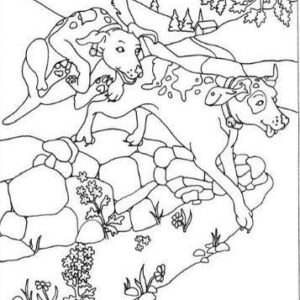The Tree of Faces: A Hidden Symbol of Connection, Identity, and Imagination
Introduction: More Than Just a Tree
At first glance, this picture looks like a tree—branches stretching outward, roots flowing into the ground. But look a little closer, and you’ll notice something extraordinary: faces carved into the very structure of the tree itself. Some are clear, others blend into the lines of bark and branches, almost daring you to spot them. This image is more than just an illustration—it’s a riddle, a story, and a reflection of how closely tied we are to nature and to one another.
The Hidden Art of Illusion
What makes this drawing so intriguing is its use of optical illusion. Our eyes naturally seek out faces—it’s a quirk of the human brain known as pareidolia. The artist uses this instinct to surprise us, weaving faces seamlessly into the branches and roots. The result? A picture that isn’t just a tree, and not just a collection of faces, but a clever blend of both. Every time you look, you might discover a new detail you missed before.
The Symbolism of Faces in the Tree
Why faces? Because they represent humanity—our history, our families, and our connections. The tree has long symbolized life, growth, and wisdom, while the faces bring an emotional depth to that symbol. Together, they tell a story of generations intertwined, like roots anchoring us to our past and branches reaching forward into the future. This “Tree of Faces” feels like a visual family tree, alive with memory and meaning.
The Connection Between Humans and Nature
This artwork also highlights something we often forget: we are part of nature, not separate from it. Just as the branches hold the faces, our lives are woven into the natural world around us. The tree isn’t just supporting human figures—it is them. It’s a reminder that every breath, every heartbeat, is connected to the environment. Without trees, there’s no life. Without roots, there’s no stability. Without branches, there’s no growth.
The Psychology of Spotting Hidden Faces
There’s something oddly satisfying about finding hidden images. It’s like solving a mini puzzle each time you discover a new face. Psychologists suggest that activities like this sharpen observation skills, improve focus, and even reduce stress. Searching for details requires patience, and the little “aha!” moment when you finally spot something hidden brings joy. This artwork doubles as both visual poetry and a playful game for the mind.
The Power of Black-and-White Simplicity
Notice how the image doesn’t rely on color. The black-and-white contrast directs your focus to the shapes, the outlines, and the clever placements of features. Without color distractions, your brain pays closer attention to detail. The clean lines make the faces both obvious and elusive at the same time. It’s a reminder that sometimes simplicity can be more powerful than complexity—less really can be more.
What This Image Teaches Us About Perspective
Art like this challenges us to look beyond the obvious. At first, it’s just a tree. Then, slowly, the hidden layers begin to reveal themselves. Isn’t life the same way? Often, the most meaningful things aren’t visible right away. You have to pause, look deeper, and train your eyes—and your mind—to notice what’s really there. Perspective changes everything.
The Timeless Appeal of Hidden Object Art
Why do people love pictures like this? Because they spark curiosity. They blur the line between art and puzzle, pulling us into the scene instead of leaving us as passive viewers. Each hidden face discovered feels like a reward. And no matter how many times you return to it, the tree always seems to offer a fresh surprise. It’s not just art—it’s interaction, engagement, and discovery all in one.
Conclusion: Finding Ourselves in the Tree
The “Tree of Faces” is more than an artistic illusion—it’s a reflection of life itself. It reminds us that we’re rooted in history, connected to nature, and surrounded by hidden layers waiting to be discovered. Every face tells a story, every branch carries meaning, and together they form a living symbol of humanity’s bond with the natural world. Next time you see a tree, think of this picture and remember: sometimes, if you look closely enough, you just might find yourself in the branches.
Would you like me to take this article a step further and turn it into a hidden-object challenge, where I guide readers to search for each face in the tree step by step? That could make it even more interactive and puzzle-like.





